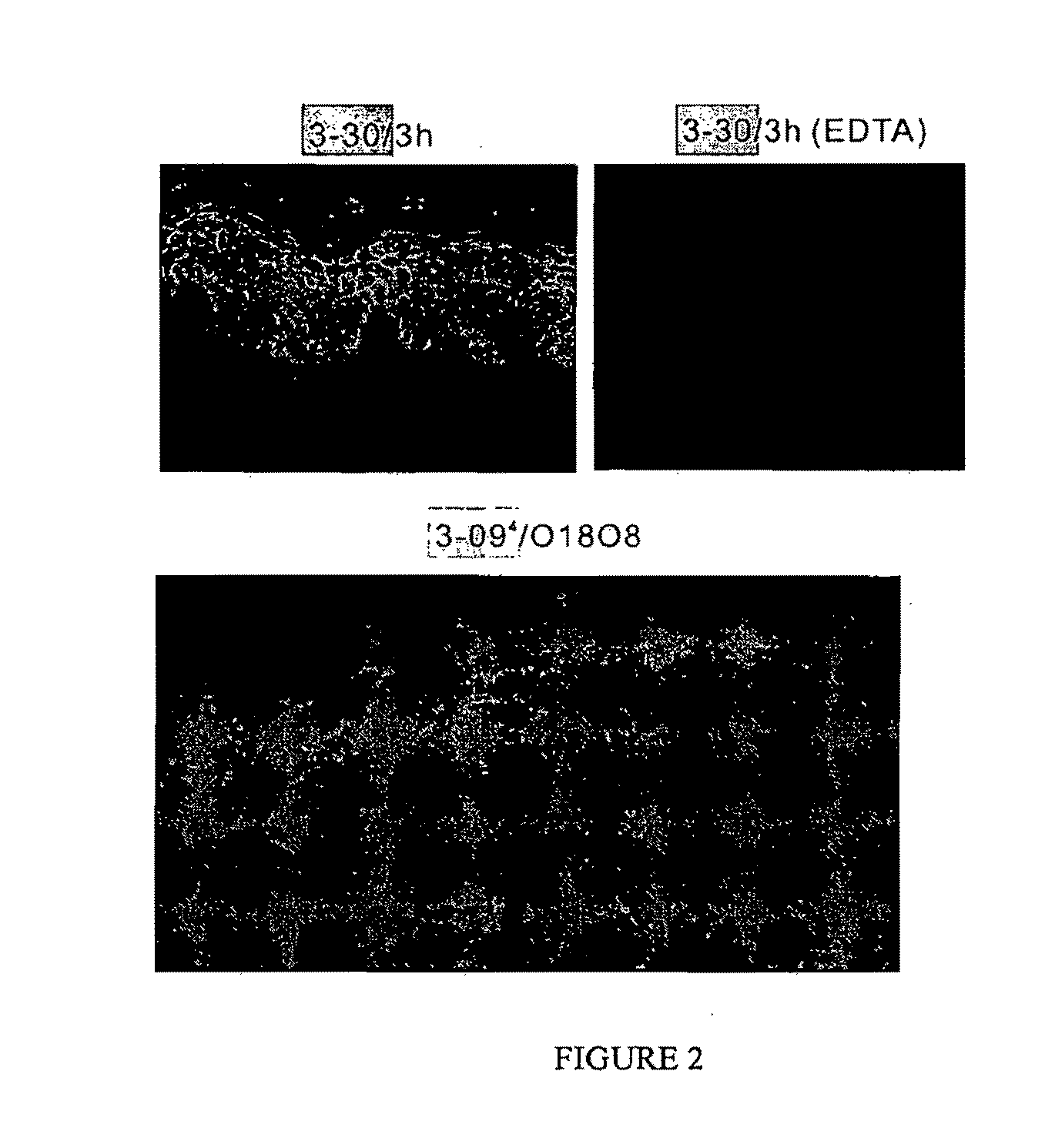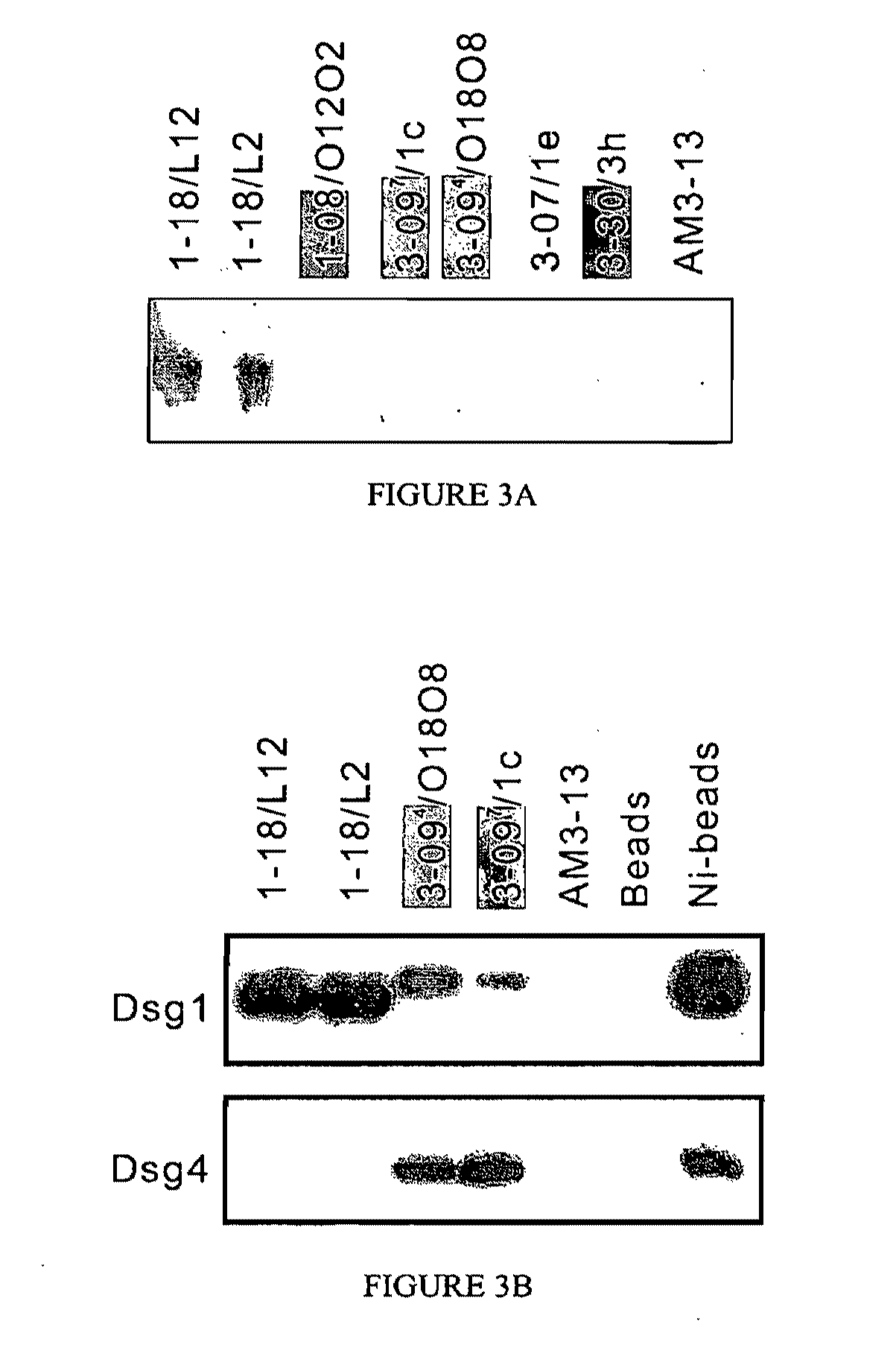Isolation of Anti-Desmoglein 1 Antibodies by Phage Display of Pemphigus Foliaceus Autoantibodies
- Summary
- Abstract
- Description
- Claims
- Application Information
AI Technical Summary
Benefits of technology
Problems solved by technology
Method used
Image
Examples
example 1
Immunochemical Properties of the Anti-Dsg 1 scFv are Associated with their Heavy-Chain Gene Usage
[0246]ELISA Analysis
[0247]Representative soluble scFvs were tested for binding to Dsg1 (FIG. 1) and Dsg 3 by ELISA. All scFvs bound Dsg1 as expected, and did not bind Dsg3, except for two 3-07 / 1e clones (differed from each other only in their light chain VJ recombination) that showed weak binding to Dsg3 at very high concentrations (data not shown). Six VH1-18 clones bound strongly by ELISA, giving an OD450=1 values at concentrations from 0.4 to 2.8 ng / ml (2 clones shown in FIG. 1, light green lines). VH3-09 clones also showed good binding; 9 of 12 clones tested gave OD450=1 values at 0.5-20 ng / ml (i.e. dark green lines in FIG. 1). The VH1-08 and VH3-07 clones showed much weaker binding, and the VH3-30 clone showed intermediate binding (FIG. 1).
[0248]Indirect Immunofluorescence on Mouse Tail and Human Skin
[0249]All VH1-18 clones stained the cell surface of keratinocytes throughout human ...
example 2
Light Chain Suffling Shows that Only Certain Light Chains can Pair with the Restricted Heavy Chains to Allow Dsg1 Binding
[0257]Although the heavy chain gene usage is generally associated with the immunochemical properties of these scFvs, and the light chain gene usage is much less restricted, light chain shuffling experiments showed that the pairing of light and heavy chains is not entirely random, as only certain light chains allow binding to Dsg1. To demonstrate the light chain contribution to Dsg1 binding, a derivative phage display library was constructed using the heavy chain of scFv 3-098 / L11 paired with the entire original light chain repertoire from the PF patient. Analysis of 16 clones from this derivative library before panning showed that none bound to Dsg1 by ELISA, even though all had the VH3-09 heavy chain. The clones did, however, bind an anti-hemagglutinin (HA) tag-coated ELISA plate, showing that the scFv (which is engineered to express the HA tag on its carboxy-ter...
example 3
Monovalent, Monoclonal Anti-Dsg1 ScFv can Cause the Pathology of PF
[0258]Initially pathogenicity was tested in the neonatal mouse model of pemphigus. Because VH1-18 and VH3-09 clones did not bind well to mouse skin by indirect immunofluorescence, it was believed seemed that theses antibodies would not bind epidermis or induce pathology, which turned out to be the case (Table 1). However, clones 1-08 / O12O2 and 3-07 / 1e did not induce pathology either, even though they did bind mouse epidermis (Table 2, FIG. 5A). Clone 3-30 / 3h, on the other hand, caused extensive gross blisters with the typical histology and direct immunofluorescence of PF (FIG. 5A).
TABLE 2Code table for PFl-scFv clonesCommonOriginal name ofVH geneVDJD segmentJ segmentVL geneclonesname in paperVH1VH1-18VDJ1D3-10 / DXP′1JH4bB3PF1-2-71-18 / B3L8PF1-2-11-18 / L8L1PF1-2-51-18 / L1L12PF1-2-61-18 / L12PF1-3-K111-18 / L2LFVK431PF1-2-151-18 / LFVK431VH1-08VDJ2D3-3 / DXP4JH6bO12 / O2PF1-2-221-08 / O12O2VH3VH3-9VDJ3D2-2JH6bO12 / O2PF1-2-113-093 / O12O2...
PUM
| Property | Measurement | Unit |
|---|---|---|
| Fraction | aaaaa | aaaaa |
Abstract
Description
Claims
Application Information
 Login to View More
Login to View More - R&D
- Intellectual Property
- Life Sciences
- Materials
- Tech Scout
- Unparalleled Data Quality
- Higher Quality Content
- 60% Fewer Hallucinations
Browse by: Latest US Patents, China's latest patents, Technical Efficacy Thesaurus, Application Domain, Technology Topic, Popular Technical Reports.
© 2025 PatSnap. All rights reserved.Legal|Privacy policy|Modern Slavery Act Transparency Statement|Sitemap|About US| Contact US: help@patsnap.com



